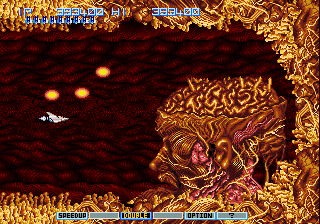

#Gradius 2 png free#
I too had heard of the game back in the 90s, probably was EGM as I had a free sub to it (never got into Gamepro but did see some.) I had a circle way around getting it too which was a bit different.

Ok that first post I swear I saw it elsewhere before and I replied to it, but this, this thread is better if anything because of that quest for Gradius II story on the bottom end of it. Still, there was nothing quite like finally opening that box a week later, shipped from Japan, and holding that chrome silver box with the iconic green and orange spaceship graphic. 10 minutes later, I was the uncontested owner of the game I had wanted for 20 years for the very reasonable sum of 35 bucks. There were no bids on it, so I groggily clicked on the auction and threw out a maximum bid because screw it, I was half asleep. A couple years ago, I was keeping an eye on an ebay auction for a CIB copy of Gradius II for the Famicom, and my ebay phone app woke me up one morning at about 5:30 with an alert that the auction had only 10 minutes remaining. The climax to this story is not particularly dramatic. I’m not one to overspend on my collection I know what things are worth and what I’m willing to pay for them, and most CIB copies I found were overpriced for my wallet. It’s not a hard game to find - I came across plenty of loose copies, but I wanted a CIB copy for a fair price. As time went on, I searched ebay and vendors at game expos for it. Even though the other versions were technically superior, I needed that Famicom cartridge.
#Gradius 2 png portable#
Over the years, I obtained and played various versions of Gradius II on other formats: PC-Engine, Sega Saturn, PlayStation Portable (PSP’s Gradius Collection was actually the first time Gradius II was officially released in the US), and even finally got to play the Famicom version via emulation on the PC and found out that yes, it was way cooler than a Famicom game should be (although even more technically impressive games came out throughout the Famicom’s life cycle).

So we had a nice little chat about how the Super Famicom was very cool, and the Super NES might be an adaptor for the NES, but unfortunately no, she did not have any original Famicom games.Īnd thus, a unicorn was born, and its name was Gradius II for the Famicom. I laughed and told her well no, here in America we didn’t have the Super Famicom yet, and I didn’t have a Genesis or TurboGrafx, so I was still playing the NES, and I was looking for Gradius II. “What you want that for? That go outta style long time ago.” I clarified that no, I was actually looking for a game for the original Famicom, and to this day, I can still hear her hilarious answer: She said, “Yes, we have nine games for Super Famicom.” I had asked if they had any Famicom games, because I was looking for a specific game. My call was answered by a very nice Japanese lady who spoke broken English and at first couldn’t understand what I was asking for. So I picked a place that had a small ad in EGM called Japan Video, located somewhere in Canada, because I think their ad said they had Famicom games. It wasn’t even yet known what form the console would take in the US: there were rumors of it being an add-on for the NES, or maybe a new console that would play both NES and SNES games, but nobody knew for sure. To give an idea of the precise point in time, the Genesis and TurboGrafx were out in the US, and the Super Famicom had just launched in Japan.
#Gradius 2 png software#
Naturally, it followed that early adopters could also buy the Super Famicom and its paltry offering of launch software before it was released in the US.Īnyway, one day I thought I’d give one of these import game places a call and see if I couldn’t track down a copy of Gradius II. Thus began the practice of import videogame collecting, adaptors (or simple physical console and cartridge modding), and new subculture among videogame enthusiasts. From what I remember, it wasn’t until Strider (and its surrounding hype - AN 8 MEG CARTRIDGE!!) came out on the Sega Mega Drive that import game purveyors began appearing in the pages of gaming magazines, promising rabid Genesis owners that for a little extra (and the purchase of an adaptor), they could play the Japanese version of this and many other games before they were available in the US. It wasn’t like today, where you can hop on ebay and spend a few bucks and have a rainbow of multicolored Famicom cassettes delivered to your door before you know it. At the dawning of the 16-bit era, import videogames were a practically mythical: previewed and reviewed by videogame mags, but unavailable to the average American gamer unless you actually visited Japan or you had some contacts over there.


 0 kommentar(er)
0 kommentar(er)
